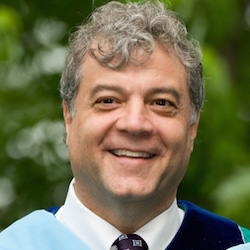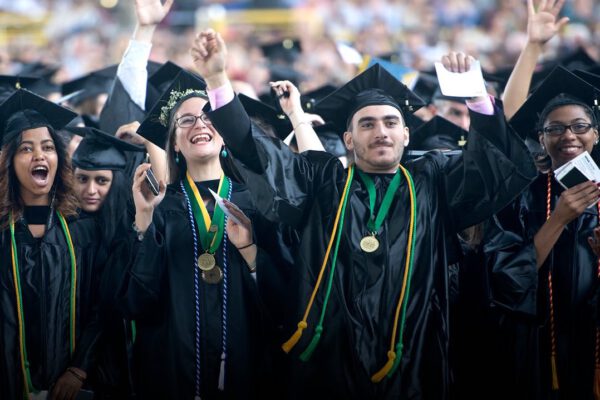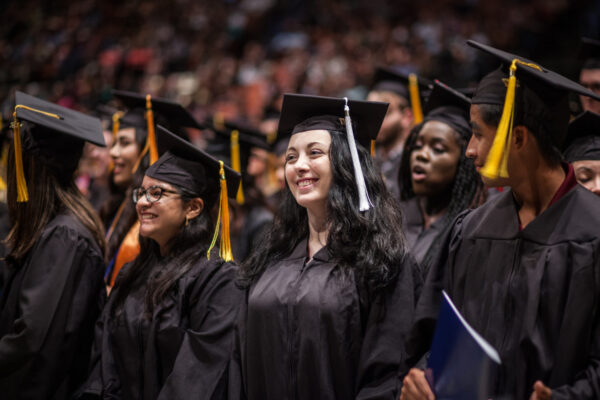Reimagining the educational model, Connecticut’s Goodwin College is becoming a major force in its community, writes Goodwin President Mark Scheinberg.
When Goodwin College outgrew its previous campus and moved to its present location in East Hartford, Connecticut, we committed philosophically to creating something new to our region: a community-based educational organization that would become a vital part of the daily life of our hometown. While the transformation had already begun from our origins as the for-profit Data Institute to a college that could truly have an impact on our region, we knew we had to make the most of this moment. We understood that it would be a unique concept here in the “land of steady habits,” but what would self-defining as community-based really mean?
To our thinking, it would be a state of consciousness steering us in more unusual directions than the expected town-gown relationship. The local impact that colleges and universities traditionally have—either from sharing resources or exerting economic power—only scratches the surface of what any higher education institution, regardless of size, can do to improve its community.
We imagined ourselves in this community-based role, then got on with building a modern campus that would provide hard-working students with needed supports and energize surrounding neighborhoods with renewed town pride—and accomplish it all with authenticity and thoughtfulness.
Today, when travelers along Connecticut’s Route 2 pass through East Hartford and gaze west toward the Connecticut River, they see Goodwin College’s main academic building, our two magnet high schools and elementary school, our Business and Manufacturing Center, and our beautiful Riverside Drive campus welcoming visitors to the riverfront. Longtime area residents often react with surprise and ask, “When did all that get there?” To be honest, our College has developed so rapidly that, even as president, I sometimes ask myself the same question.
I believe it’s in our DNA to do things differently at Goodwin. Beginning as a small business technology training center and keeping the needs of our students and potential for future development in mind, we grew into Goodwin College: a career-focused, nonprofit, degree-granting educational institution that sought to be an economic contributor to Connecticut, graduating well-trained professionals ready to enter the workforce. We spoke to employers about their greatest needs among new hires and designed our certificate and degree programs accordingly.
As Goodwin College began to take shape, two main concerns emerged: one centered on our students, the other focused on our hometown of East Hartford. We took it to heart to do the best we could to address both the academic and economic issues in a holistic manner.
Serving Students Without Stigmatizing Need
We saw our students struggle with challenges that could derail them from their planned studies. Many worked full time or had young children—currently, 81 percent of our students are women. A great many were first-generation college students with families that didn’t always understand their desire to advance their education.
At our new employee orientations, Dan Noonan, our vice president for enrollment, marketing, and communications, always observes: “The students we serve are our inspiration. The challenges many of them face in pursuing their education are daunting, and that is never far from the minds of our faculty and staff. We understand that it is an honor to serve them.” We never forget that economically challenged students have pride, a core belief in our school community. We provide our support services without stigmatizing need.
Goodwin opened its food bank years ago, as have a number of colleges. In addition, we empower our financial aid advisors to help students understand their eligibility for food stamps and energy assistance. Local organic farmers are encouraged to use our undevelopable land in exchange for produce equal to typical rental fees. Bushels of this fresh produce are available in our lobby along with nutritional recipes for students to pick up through our Fresh Food Initiative.
Individuals who are receiving Supplemental Nutrition Assistance Program benefits and have a high school diploma or GED are eligible to enroll in our SNAP Employment and Training Program at no cost. They are able to strengthen their skills and improve their opportunities for employment as office support staff, security and administrative professionals, human services assistants, bookkeeping clerks and basic CNC operators.
The list of support services continues to grow. Our diaper bank keeps our young mothers from choosing between diapers and food while trying to concentrate on their studies. On-campus early Head Start programs and magnet schools earmark a number of spaces for the children of Goodwin students.
Some may see this comprehensive support as creating dependency. In reality, we increase the chances that they will see their education through to completion and step away from dependency.
The Town We Call Home
As we grew, we saw the town that we loved struggling to regain its identity as a business and industry leader. Our neighbors, United Technologies Corporation’s Pratt & Whitney and Coca-Cola, were still active employers, but much of downtown had seen better days after years of challenges.
For decades, the East Hartford community had been cut off from the river by oil tanks that contaminated rich land that once served as farms and tobacco fields. Most of the properties along Riverside Drive were abandoned and tax delinquent. One of our first priorities had to be making our new campus something the entire town could celebrate.
Fast forward to today. Thanks to funding from federal, state and local environmental agencies, along with our own resources, Goodwin College has reclaimed and amazingly transformed these former brownfield sites. Gone are the abandoned oil tanks that separated the town from the river. Thanks to innovative environmental cleanup methods, these previously contaminated properties have become a source of town pride. Now, first thing in the morning, you often see students arriving for class at the same time local senior citizens are strolling down to the river with their fishing poles.

We understood that revitalizing the surrounding neighborhoods was critical to Goodwin’s success. What would we ultimately accomplish by putting up an intentionally and thoughtfully designed campus, only to have it surrounded by poorly maintained roads and less than desirable businesses? In a letter of support for a 2013 plan of conservation and development created by the Town of East Hartford, we stated that, “Goodwin College is fully committed to the long-term growth and vitality of the community in which it has chosen to grow its campus. Colleges play an important role by contributing to the economy, civic life, and environments of cities and towns by attracting human capital and boosting the skills of the workforce. In turn, the town and neighborhood support the colleges’ ability to function well by offering the public services and social and cultural amenities that add to the quality of life that helps to keep people and jobs in the area.”
To support the progress we’ve made, Goodwin has strategically acquired most of the property surrounding the campus. Understandably, this has raised more than a few eyebrows around town and among state legislators. People wonder what a college is doing buying up all this land. Isn’t that taking taxable properties off the town tax rolls?
In fact, Goodwin has voluntarily kept properties on the tax rolls. In addition, we have acquired a number of public properties that have been added to the tax rolls. Over time, Goodwin has become one of the largest taxpayers in town, second only to Pratt & Whitney. We also regularly put considerable resources into improving town facilities—many unrelated to the campus—as a sign that we are investing in an improved quality of life for our neighbors.
“There’s no denying that this end of town is simply a different East Hartford than it was only a few years ago,” said Todd Andrews, our vice president for economic and strategic development. “We do move fast, and we get things done, and naturally people wonder what’s behind it all. But we believe we are offering proof that all of us—our employees and the town residents—are part of something exciting and new. We’re bringing back a thriving town, we’re bettering the lives of our students through career-focused degrees, and we’re improving area businesses with better prepared employees.”
Committed to the Community
In the true spirit of our community, changes at Goodwin continue to come at a breath-taking pace—and I can’t see it working any other way. In another part of our letter of support for the town’s plan, we pointed out that local governments increasingly have recognized the importance of colleges and universities as anchor institutions in community development a paradigm that encourages partnerships among public, private and nonprofit sectors to solve local issues.
Almost anywhere you look in our town, you’ll see signs of Goodwin College’s presence. In our 60-plot community garden, members of the college and town communities—from our magnet school toddlers to local seniors—get to know each other by meeting, literally, on common ground. Our $10,000 homeowner incentive helps stabilize neighborhoods by encouraging employees to purchase homes in East Hartford. Our nursing students participate in clinical experiences in a number of area hospitals. Local residents take advantage of free services provided by the students in our outstanding dental hygiene clinic and vision care technology-training store. In some cases, our students bring these services out to community settings. A recent Intergenerational Students grant from the Council of Independent Colleges will allow our occupational therapy assistant and human services students to help address social isolation and related health risks among seniors at a local rehabilitation center.
Students in our sustainability-themed magnet high school are learning how modern manufacturing methods are addressing environmental stewardship. Thanks to our Early College programming, these area high school students can enroll at Goodwin having earned up to 30 tuition-free credits—their freshman year essentially completed at no cost to their families.
As of this writing, Goodwin College has recently received approval from the New England Association of Schools and Colleges to offer graduate programs, and we are currently recruiting the first candidates for our master’s degrees in nursing and in organizational leadership. We plan to welcome our first cohort of international students in the fall of 2017.
I can’t say that it’s easy for people to understand this college/elementary school/high school/economic driver/community-service organization. Overall though, I sense our special place in the community becoming stronger, more trusted and increasingly valued. And for a group of educational dreamers who set out with little more than optimism, that’s not too bad.
If you have any questions or comments about this blog post, please contact us.



